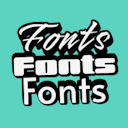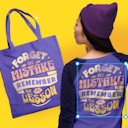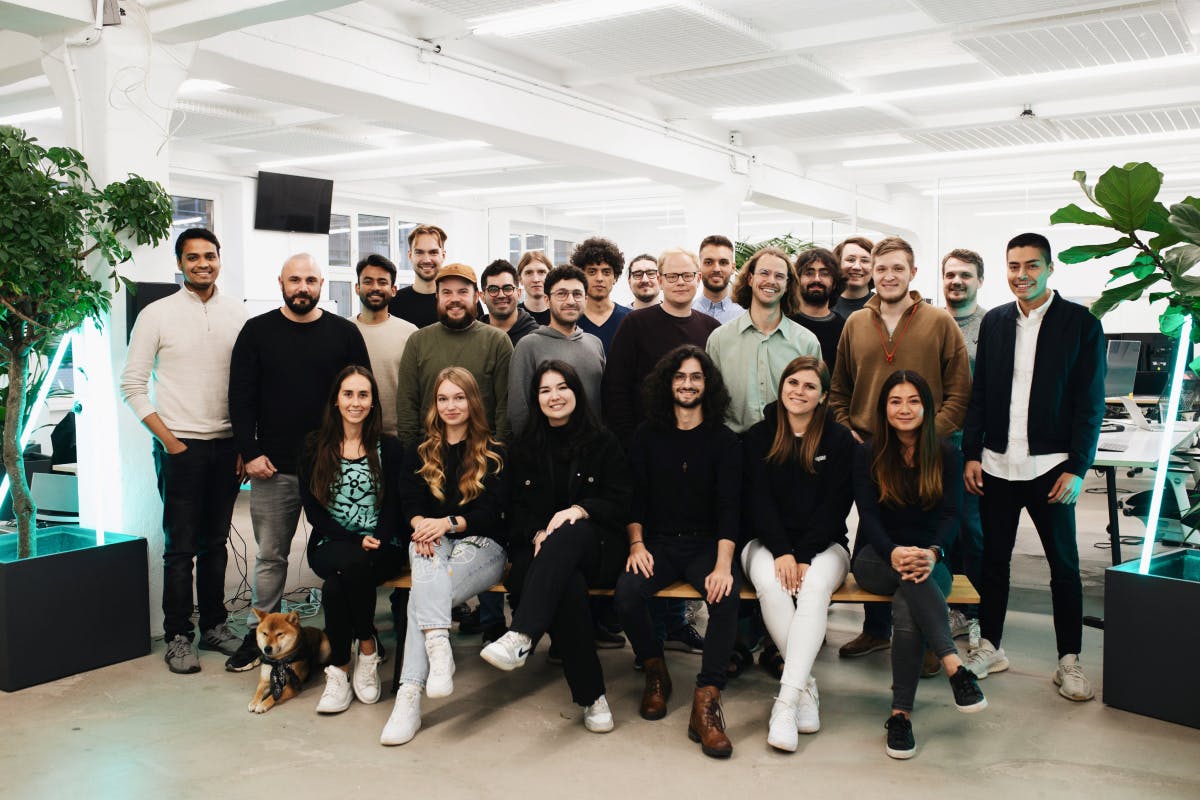Product
Templates
Resources
Company
Home
Blog
Design
Bauhaus art in graphic design: Big shapes, bold colors, and surprisingly many decisions
Bauhaus art in graphic design: Big shapes, bold colors, and surprisingly many decisions
As a German-based design platform, it feels borderline sinful not to talk about Bauhaus art. It’s the German-born design movement that taught us how to strip things back, focus on function, and make minimalism actually interesting. Leaving it out? Feels like betrayal.
Bauhaus is everywhere. And if you don’t think it is, maybe this article can help you find it in our everyday lives (and probably in our Pinterest boards).
With its bold shapes, clean lines, primary colors doing the most with the least. It looks simple. But if you’ve ever tried to recreate that vibe, you know the struggle.
You drop a circle, a square, and some text on the canvas and think, easy. Five minutes later, you're spiraling, thinking “WHY DOES IT LOOK WEIRD??” and wondering whether geometry has personally wronged you.
But here’s the fun part: once you get what makes Bauhaus tick, it goes from frustrating to kind of addicting. It teaches you how to make less feel like more — with structure, color, and type all pulling their weight.
So let’s talk about it. The history, the principles, and how to take all that Bauhaus goodness and make something fresh, fun, and with your personal twists.
Can’t wait? Explore instantly in your own canvas here.
Table of Contents
- What is Bauhaus Art?
- The challenges in designing Bauhaus Art
- Bauhaus seen in architecture
- Bauhaus seen in product design
- Bauhaus seen in UI digital design/a>
- Bauhaus art principles
- Bauhaus free templates from Kittl
- Bauhaus art principle 1, form and function
- Bauhaus art principle 2, language with geometry
- Bauhaus art principle 3, limited color palette
- Bauhaus art principle 4, fonts and typography
- Bauhaus art principle 5, all about assymetry
- Tutorial on how to make Bauhaus art designs
- Step 1, Grids in Bauhaus Art
- Step 2, Shapes in Bauhaus Art
- Step 3, Color Palettes in Bauhaus Art
- Step 4, Adding Typography in Bauhaus Art
- Step 5, Balancing Elements in Bauhaus Art
- Bauhaus art templates from Kittl
- Designing Bauhaus art in Kittl
What is Bauhaus Art, really?
You’ve probably seen Bauhaus without even realizing it. But before that, let’s back up a bit.
In 1919, fresh off the chaos of World War I, a group of designers, architects, and artists in Germany looked around and said: What if we stop decorating everything like it’s 1890 and start designing like the future actually matters?
That idea became the Bauhaus — a radical design school that tore down the walls between art and industry. Instead of keeping painters in one room and cabinet-makers in another, Bauhaus blended everything: craft, architecture, type, textiles, furniture, posters.
It didn’t last long (14 years before it got shut down), but it left a legacy: a whole new way of thinking about form, function, and the way we move through the world.
Imagine taking a chair, a building, and a poster—and giving them all the same design brief: look good, work better, and never waste anyone’s time. That’s Bauhaus art.
Even if you’ve never said the word out loud (it’s “bow-house,” btw), you’ve seen it: in IKEA furniture, subway signage, startup branding, and probably every minimalist logo you find on the street.
Maybe these classic Bauhaus art examples can help you refresh your memories:
They embraced asymmetry when everything around them was symmetrical. They made bold typography part of the artwork itself. They let function lead, but never at the cost of creativity.
And the ripple effect? Massive. Mid-century modern furniture? Bauhaus influence. The Helvetica-dominated posters in the subway? Bauhaus echoes. Clean, grid-based layouts in UI design? That’s Bauhaus DNA, too.
Why Bauhaus Art is hard to master (but totally worth it)
Here’s the trap: Bauhaus looks easy. A few shapes. A couple of lines. Maybe some red and yellow. Boom. An instant masterpiece, right? Yeah… no.
Designing in a Bauhaus style is like writing a haiku. You’ve got very limited ingredients, and every single one has to hit. You can’t just throw in “something cute” or “a little flair.” If it’s not doing a job, it’s messing up the balance.
That’s what makes it hard. There’s nowhere to hide. There’s no gradients to distract, no decorative fonts to save you. It’s you, the grid, and your ability to make three shapes feel like a full sentence.
But here’s the plot twist: that’s also what makes it fun. Because once you stop trying to over-design and start making smart, intentional choices, things click. A red square in the right spot feels like a mic drop. A perfectly aligned headline? Delicious.
Bauhaus is minimalism with meaning — and it forces you to think harder, design better, and celebrate the magic of restraint. You’ll curse it at first. Then you’ll get hooked.
What Bauhaus Art looks like in the wild (spoiler: it’s everywhere)
Bauhaus wasn’t built to stay in a gallery. It broke out. Ran wild. Settled into architecture, fashion, product design, UI — you name it.
Once you see it, you see it everywhere. Here's where it shows up and how it's still quietly running the show:
🏢 Architecture
Bauhaus buildings are like minimalist moodboards brought to life. It usually has no columns or frilly cornices. Just flat roofs, geometric windows, and walls that look like spreadsheets (in a good way).
Think: clean white boxes with just enough detail to look sharp, never showy. They're the blueprint behind every design hotel and startup HQ with concrete floors.
What better way to show you the example than the Bauhaus Dessau itself, the OG campus.
🪑 Product Design
Imagine furniture made of bold lines and zero ego. That’s Bauhaus.
Steel tubes, leather straps, and no extra anything. Form follows function so hard, you could draw the whole chair with a ruler and still want to sit in it forever.
As the perfect example, see the legendary Wassily Chair—absolutely iconic.

Image by Better Homes
📱 UI & Digital Design
Ever opened an app and thought “Ooo, clean”? That’s Bauhaus too.
Color-block navigation? Giant headlines? Buttons that are literal rectangles? All straight from the Bauhaus playbook — just with WiFi.

Image by designers at Kittl.com
And if you’re a graphic designer? Bauhaus is basically baked into your daily workflow.
Posters with bold type and a single color block? Bauhaus. Logos that ditch the icon and go all-in on letterform? Bauhaus. Packaging that feels premium without a drop of gold foil? You guessed it.
And sure, it’s hard to master. That whole “less is more” thing? It takes taste, balance, and a little bit of grid-based therapy.
But with the right tools and a clear starting point, it’s totally possible to create something smart, sharp, and wildly satisfying without all the overthinking.
So if you’re ready to try it for yourself, let’s break down how you can start doing it.
The Bauhaus Art cheat sheet (aka: what actually makes it feel Bauhaus)
Minimalism is easy to fake, but Bauhaus simplicity? That’s a whole different beast.
Simplicity demands confidence — and precision. That’s why working in a Bauhaus style can feel both frustrating and addictive. It forces you to slow down and ask: Does this need to be here? Is this helping or just filling space?
If you want to start creating Bauhaus Art posters like this:
Well, here’s the vibe checklist. If your design hits a few of these, you’re on the right track.
✦ Form follows function
At its heart, this principle is about honesty. If something’s on the page, it needs to be there for a reason. Imagine a business card: instead of cramming in patterns or background textures, it uses bold typography, perfect spacing, and just enough contrast so the information reads in a blink.
That confidence — stripping away everything but the essentials — feels powerful. In a world that constantly asks us to add more, Bauhaus says: add purpose.
Try this: Next time you're designing a logo, flyer, or landing page, ask: What’s this element doing for me? If you can't answer, it's probably in the way.
✦ Geometry as language
Bauhaus didn’t use shapes for decoration. They used them to communicate.
A square gives grounding. A circle creates movement. A triangle points — literally and visually — to what matters. It’s storytelling without a single word.
Try this: Build your next layout using only shapes first. If it works before you add any text, you’re already halfway there.
✦ Bold, limited color
Bauhaus designers didn’t need 40 swatches. They picked a few colors and used them on purpose — usually red, blue, yellow, black, or white. The palette was small, but the impact was huge.
Use color to guide the eye, not distract it. Think: neutral layout, one punchy hue, and restraint everywhere else.
Try this: Stick to black, white, and gray. Then add one bright color. If you're reaching for a second pop, pause. Ask: Does it actually help?
✦ Typography in the equation
In Bauhaus design, type isn’t just something you read — it’s part of the composition.
Imagine a magazine spread where the headline sits confidently off-center, large enough to double as a shape, balancing out the photography.
Or a poster where letters are stretched and scaled, becoming part of the structure rather than floating on top of it.
Bauhaus typography is functional and sculptural.
Try this: Choose a clean sans-serif and treat it like a shape. Align it with your layout, not just your content. See what happens when you let the type live in the space.
✦ Asymmetry done on purpose
Symmetry is safe. Bauhaus didn’t care for safe. They used imbalance to create energy.
A red circle placed just off-center. A block of text nudged diagonally. Suddenly your design has tension, rhythm, and life.
Try this: Take your perfectly centered layout and shift one major element to the side. Feel the difference? That’s what keeps the eye moving.
How to design in a Bauhaus Art style (without getting lost in the grid)
Alright, you’ve got the context, the principles, and probably a few tabs open with red squares and bold fonts. Now let’s actually build something. Whether it’s a poster, a social post, or a fake jazz festival flyer just for fun — here’s how to make your own Bauhaus-style design from scratch.
✦ Step 1: Start with a grid
Bauhaus and grids are soulmates. Open your design tool (Kittl is perfect for this), turn that grid on, and let it guide your layout. It’ll keep your shapes tidy, your text aligned, and your sanity intact.

✦ Step 2: Block in your shapes
Begin with your basics — squares, circles, triangles. Don’t overthink it. Drop them in and start moving them around. Stack them. Layer them. Let one overlap another slightly. Your goal isn’t perfection. It’s rhythm.

✦ Step 3: Limit your colors
Two to three colors, max. Maybe a red square, a blue triangle, a yellow accent — plus black or white for balance. That’s it. The fewer colors you use, the more powerful they feel.

✦ Step 4: Add your type (and make it part of the design)
Use a bold, clean sans-serif — something geometric, confident, and not trying too hard. Align it with your shapes. Scale it up or rotate it if it feels right. Let the text interact with your layout, not just sit politely in the corner.

✦ Step 5: Zoom out and balance it
Symmetry is fine. But Bauhaus often gets its energy from being just a little off. Push a shape to the side, scale up a headline, leave space where you’d usually fill it. Then zoom out and adjust until everything feels like it belongs — even if it breaks the rules a bit.

Or if you're a more visual learner, you can also check out our YouTube video about it here:
Bauhaus-inspired posters and templates you can start with
Want to skip the blank canvas panic? We’ve got you.
Sometimes the hardest part of Bauhaus design is just getting started. That’s where templates come in — not to box you in, but to give you a confident jumping-off point.
Whether you’re making a poster, a print, a social graphic, or just messing around with color and shape, these Bauhaus-style templates give you structure, balance, and plenty of room to make it your own.
Of course, all thanks to our Kittl community for this inspiring pieces too!
Why Kittl just gets Bauhaus Art
Bauhaus design demands discipline. You’re not hiding behind textures or over-the-top effects — you’re working with structure, shape, type, and space. When every element has to earn its place, your tools need to be just as intentional.
Kittl gives you exactly that. Not clutter, not complexity — just a clear, responsive space to build with purpose.
You get full control over grids, alignment, scaling, and spacing. Vector shapes that snap cleanly into place. Fonts that feel like they were designed for this style. And every edit you make feels instant without wrestling with a thousand settings or plugins.
Our Kittl Editor is not trying to be everything, it’s trying to stay out of your way — so you can stay in flow, move fast, and focus on composition, not software gymnastics.
Whether you're starting from a template or building from scratch, Kittl gives you room to experiment without compromising control.
And when you’re done, you’re done. No jumping between tools just to export, mock up, or share. It’s all here — in one clean, focused workspace that respects the way designers actually think.


























